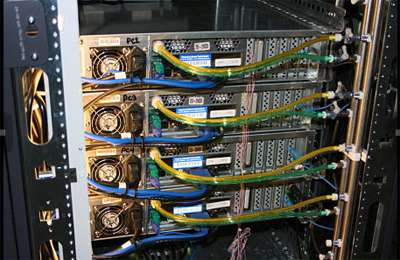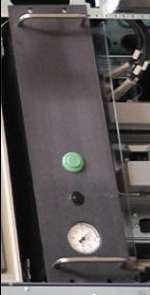Closeup of the back of the server rack with Cool-Flo installed. The coolant flows through the tubes into the server and carries the heat out like a circulatory system.
(Phys.org)—The California Institute for Telecommunications and Information Technology (Calit2) at the University of California, San Diego has become the inaugural test site for a new approach to cooling computer servers – a technology that could improve energy efficiency and enable higher-performance computing.
The Cool-Flo technology was developed by Steve Harrington, CEO of Flometrics, Inc., and an expert in fluid dynamics and thermodynamics. Harrington earned his Ph.D. in applied mechanics at UC San Diego, and is a part-time instructor in UCSD's Mechanical and Aerospace Engineering department, where he teaches a senior design course in aerospace engineering in which undergraduate students instrument, build and fly hybrid rockets. The technology was installed in the Calit2 server room as part of ongoing research led by Computer Science and Engineering professor Tajana Simunic Rosing into energy efficient data centers.
Flometrics installed the new Chilldyne Cool-Flo negative pressure liquid cooling system as a pilot program to cool three 1U servers in the Calit2's server room in Atkinson Hall on the UC San Diego campus. The servers monitor processor, RAM and chipset temperatures, as well as the total power consumed by the servers, while running typical research loads.
The technology is a server-agnostic, rack-based, direct-to-the-chip and leak-free liquid cooling system that can be used to cool any server. It is based on rocket-cooling technology and utilizes a pump developed with a grant from NASA's Small Business Innovation Research program.
Cool-Flo pump, with simple stop/start interface, is conveniently located uder the server rack for easy access.
Cool-Flo also utilizes a proprietary no-drip, hot swap connector enabling technicians to remove servers while the system continues to cool the remaining servers. The technology also uses negative-pressure coolant flow that eliminates leaks.
Though initially conceived as an energy-efficiency solution, researchers discovered that liquid cooling enabled faster processors and increased rack densities, thereby providing improved high-performance computing.
This video is a demonstration of our fail safe system in case the tubing breaks or gets cut. Watch as the liquid is safely and cleanly withdrawn so that no electronics are damaged from stray drips.
"Not only is there an advantage of power reduction by 25 to 35 percent, but you are lowering existing CPU temperatures by 30 degrees Celsius, resulting in practically unlimited density," explained Harrington. "Cool-Flo is a good fit for Calit2's server needs given the institute's commitment to reducing the energy intensity of campus IT and improving energy efficiency."
The system's reduced power needs are derived from the elimination of HVAC, reduced leakage of electrical current from CPUs, and reduced power needed to run servers' fans.
The Cool-Flo system has a method for just disconnecting one server from the cooling for quick "swapping" or disconnecting of servers. The system prevents any dripping and is as easy as unplugging a computer.
According to Harrington, the system reduces the power usage effectiveness (PUE) of data centers from 1.6 to 1.1 or less. The Green Grid Consortium's 'ideal' PUE, a measure of total facility power divided by IT equipment power, is 1.0.
"We are pleased to host this novel approach to computer cooling, which enables the use of liquids (water with a rust inhibitor, or perfluorocarbon) for improved heat exchange, while minimizing the risk of leaks in the data center," said Calit2's technology infrastructure manager, Tad Reynales.
More information: A visualization of the system can be seen at www.chilldyne.com
Provided by University of California - San Diego






















